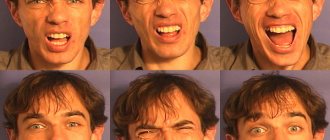The attack passes as unexpectedly as it began. The individual has no memories of him, but sometimes they are fragmentary.
The twilight state of consciousness can last several minutes, days, and sometimes longer. It necessarily requires serious treatment by psychiatrists, since it poses a danger to both the person suffering from it and the people around him. Therefore, in the event of an attack, immediate hospitalization is necessary.
Causes and types
The causes of pathology are divided into two groups:
- organic - epilepsy, epileptiform syndrome, brain diseases, including tumors, damage to the medial temporal regions as a result of traumatic brain injury and a number of other conditions;
- functional - hysterical psychoses and narrowing of consciousness, affective states, unexpected situations with consequences in the form of severe psychological trauma.
There are twilight psychotic and non-psychotic disorders. The first include the following types, which have characteristic manifestations:
- Dysphoric twilight state of consciousness. A person acts in an orderly manner, he is self-absorbed, detached from the outside world, sad, does not respond to someone addressing him, or utters some stereotypical words that are not related to what the interlocutor is saying. The face is gloomy, even angry. Such patients can recognize familiar people and situations, but act inappropriately and are unable to critically evaluate what they are doing. Fleeting sensations of having a double, birth and death, etc. may arise.
- Delusional twilight disorder of consciousness. Delusional ideas are formed, and the patient’s behavior corresponds to their content. It seems to him that someone is pursuing him, wants to harm him, make him suffer, kill him. He is focused, behaves in an orderly manner, but normal communication with him is impossible. The patient’s actions are aimed at protecting against an imaginary threat dictated by delusion, most often antisocial. When the condition returns to normal, memories of the experience remain.
- Hallucinatory disorder is characterized by the presence of illusions and frightening visual and auditory hallucinations. Communication is impossible, since such a patient does not perceive reality and the appeal to him at all. He hums, pronounces or shouts individual words or phrases, most often inarticulate. As a reaction to terrible visions, aggression arises, the outbreaks of which result in very harsh actions performed with enormous force - beating, killing with bare hands or with the help of sharp objects.
A number of psychiatrists identify another type of psychotic twilight state of consciousness - oneiric. It is characterized by colorful fantastic or fairy-tale hallucinations, accompanied by catatonia - impaired motor functions, i.e. excitement or stupor.
Non-psychotic cloudings of consciousness include:
- Somniloquy - talking in your sleep.
- Somnambulism - sleepwalking, sleepwalking. Occurs in children and adolescents.
- Trances are long-term automatic actions. Most often, the patient leaves for another city.
- Outpatient automatisms are brief automatic actions. For example: a person leaves home, gets on public transport, and, upon waking up, finds himself incomprehensibly how and why in an unfamiliar place. The patient looks confused, thoughtful, there are no hallucinations or delusions. He does not remember at all what happened to him in a state of darkness.
- Genser's syndrome is a hysterical variant that occurs as a result of prolonged stress. The impetus for the development of the disorder is some kind of traumatic event, an unexpected exposure to unsafe, unusual conditions. The patient can only talk about these events, but he is not alienated from the world. The individual behaves like a clown, “falls into childhood” - he lisps, grimaces, and obviously answers simple questions absurdly. Knowing the purpose of things, he distorts their use, for example, he tries to pull gloves on his feet. Emotions suddenly change to the opposite. After an attack, the patient has fragmentary memories of what happened, which are restored after a good sleep.
The twilight state takes a person from reality to hallucinations. The latter replace a situation that was traumatic for him. Examples of darkness: amok - excitement, aggression and murder; the ritual of shamans - they introduce themselves into darkness and “infect” the participants in the action with it. An example can be given from literature - Lady Macbeth, the heroine of Shakespeare's tragedy of the same name, experiences a twilight episode in her sleep.
How to get rid of the deja vu phenomenon
As we have already understood the nature of the influence of the phenomenon under consideration, it is worth considering whether it is necessary to get rid of it. Experts advise to be wary if the effect is accompanied by any pathological signs, for example:
Overthinking one situation too often
Increased anxiety when experiencing déjà vu
The effect lasts too long
Hallucinations
Physical and mental illness
In cases where you experience these symptoms during déjà vu, it is imperative to see a doctor to diagnose the condition.
General symptoms
In a state of twilight disorder of consciousness, whatever type it may be, contact with the patient is impossible, since he is detached from the real world, does not perceive it partially or completely. His consciousness suddenly seems to turn off. He is disoriented to varying degrees in the situation, time, people, place. His thinking process is disrupted, his judgments are incoherent or completely absent.
It is difficult to distinguish a sick person from a healthy person by appearance, since he behaves quite normally and is capable of performing quite complex actions. However, as soon as you begin to communicate with him, it immediately becomes clear that the individual cannot say either his own name, the names of loved ones, or the date where exactly they are. Although his speech may be correct from a grammatical point of view, he cannot carry on a conversation, he talks to himself, does not answer questions and does not expect an answer to his own.
The behavior is usually aggressive and poses a danger to others.
After emerging from such a state, the patient remembers poorly or does not remember at all what happened to him and what he did.
From past to present
The term “déjà vu” was first used at the beginning of the 20th century by the French psychologist Emile Boirac in his book “Psychology of the Future.” The author used this term to reflect the concept of derealization, which implies a violation of the perception of reality, accompanied by a feeling of unnaturalness and unreality of the environment. Simultaneously with déjà vu, other phenomena were described [1] related to derealization disorders [2–5]:
déjà vécu (if deja vu is the visual perception of information, then déjà vécu is at the level of feelings and emotions; “already experienced”);
déjà entendu (auditory perception, “already heard”);
déjà baisée (motor, sensory, “already tried”);
déjà lu (superimposition of images perceived through reading, “already read”);
déjà eprouvé (emotional perception, “already experienced”);
jamais vu (jama vu, the inverse of the term “déjà vu” - “never seen”).
All these phenomena occurred quite often, and, like many phenomena that are difficult to find an explanation, déjà vu quickly became covered in a veil of secrecy, which many scientists tried and are trying to uncover. Explaining the occurrence of a specific déjà vu is a difficult, sometimes impossible task, because it is impossible to predict the exact time of manifestation of the phenomenon, and it is not so easy to cause it artificially. And since it is difficult to explain this entire complex of phenomena using scientific methods, a large number of dubious theories and incredible, sometimes mystical assumptions arise.
Urgent Care
The danger of twilight disorder of consciousness is that the patient, under the influence of hallucinations, anxiety, and anger, can cause quite serious harm to himself and others, since extreme strength and aggression awakens in him. He can attack anyone nearby, destroy furniture, etc.
To avoid accidents and other negative consequences, you need to react to this condition very quickly. Of course, it is necessary to call an ambulance, but before the arrival of a specialized team, to ensure the safety of the patient, the patient should be persuaded to sit or lie down on the bed and not be left alone for a minute. It is necessary to ensure that there are no breakable or piercing objects, flammable or other dangerous substances nearby. You should not let him near windows, balconies, or doors.
For safe transportation of the patient, he is fixed and 2-4 ml of sibazon solution (0.5%) or Relanium, Seduxen, diazipam is administered intravenously. This is usually enough to calm him down. If the drug does not work, after 10 minutes you will have to administer half the dose of the same medicine. Neuroleptics with suprastin or diphenhydramine, as well as chlorpromazine, have a similar effect, but it lowers blood pressure, so it is not suitable for everyone.
A gloomy state can be a manifestation of epileptic seizures, then the gloom can be one-time or repeated. If a diagnosis of epilepsy is made and medications are prescribed, then the attack can be stopped with the prescribed medications. If psychomotor agitation does not go away, but increases, then mandatory hospitalization is required.
Is deja vu good or bad?
According to scientific studies of the phenomenon of déjà vu, 60-80% of people have experienced it at least once in their lives. Freud called the effect in question “déjà vu is a trace of forgotten experiences.” And Aristotle called it “a malfunction of the brain.” This raises the question: does the occurrence of this phenomenon have such a bad effect on a person?
No one can give you a definite answer. Scientists are inclined to believe that déjà vu itself is a fairly neutral phenomenon, and the degree and number of its manifestations already determine the nature of the influence on a person. For example, in medicine, in particular psychiatry, it has been recorded that a frequent and obsessive sensation of this effect is associated with the development of human mental and neuralgic disorders. Such disorders are epilepsy, dementia, schizophrenia, and an overly sensitive nervous system. In addition to disorders, experts emphasize the negative impact of déjà vu on people with depression, complexes and other mental wounds.
Treatment
The diagnosis of “twilight disorder of consciousness” is made by a psychiatrist, studying the clinical picture and based on a conversation with the patient and his relatives. You will also need a consultation with a neurologist and a number of specialized specialists, as well as studies such as MRI and CT of the brain, EEG, etc.
If during the process of darkening the patient committed a crime: caused damage to property, harm to health or murder, then a forensic psychiatric examination is carried out. It, among other things, involves the study of documents compiled by law enforcement officers, forensic reports, and witness statements.
Treatment is carried out in the psychiatric department of the hospital with the help of antipsychotics and tranquilizers. The psychotic type of disorder will require individual psychotherapy. It is necessary in the event of a crime committed by a patient.
If the twilight state is of a non-psychotic type, then the underlying disease is treated.
Naturally, individual treatment tactics are selected for each patient, depending on the above factors.
Memory of past lives
The first attempts to explain the phenomenon of déjà vu were associated with the emergence of irrational interpretations and hypotheses. There is a theory that every person has a so-called gene archive, in which the ancestral memory is preserved - the memory of parents, grandparents, all ancestors down to the founders of the human race. Based on this theory, déjà vu is “reading” pieces of the memories of our ancestors.
There is a similar theory of déjà vu - based on the doctrine of multiple transmigration of the soul. From time immemorial, people believed in life after death - afterlife or reincarnation. Subsequently, this idea was chosen by many philosophical schools. One of the first philosophers to become interested in the phenomenon of déjà vu was Pythagoras, who claimed that he could remember moments and events from his past lives. This point of view was shared by the equally famous ancient Greek philosopher Plato. He believed that the spiritual component of a person, before entering the body, contemplates the world, “remembers its past lives.” And the phenomenon of déjà vu is a reminder of the path that the soul chose when it was reborn in your body.
These two theories echo the concept of the collective unconscious developed by Carl Gustav Jung. The Swiss psychiatrist and philosopher said that as a young man, while visiting, he saw an old porcelain figurine depicting a doctor. The figurine was unfamiliar to him, but he recognized the doctor’s shoes as shoes that allegedly once belonged to him. Then he came to the conclusion that in a past life he was a doctor.
The theory based on the belief in reincarnation is still popular today. Its author is hypnotherapist and regression therapist Dolores Cannon. She developed a hypnosis technique that allows patients to be put into a trance and receive historical information.











